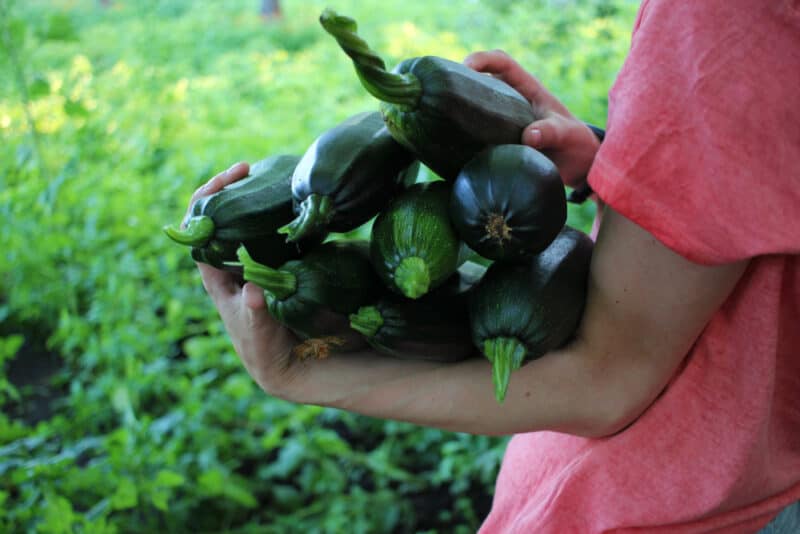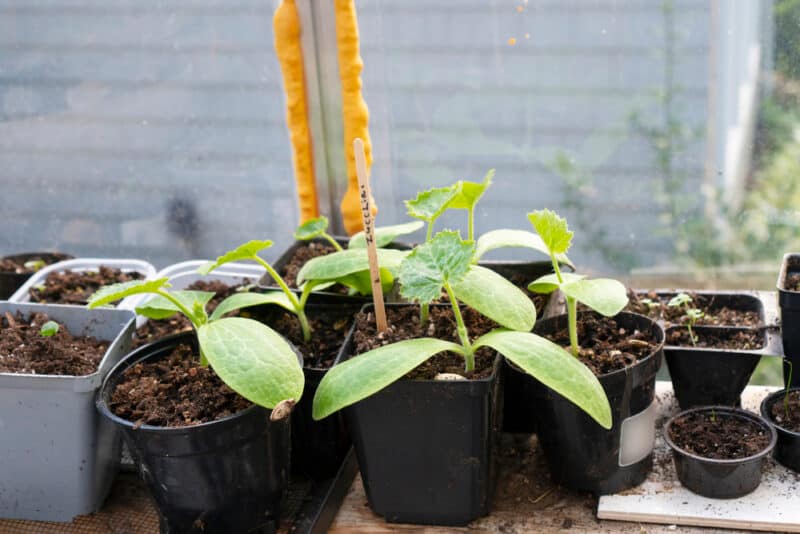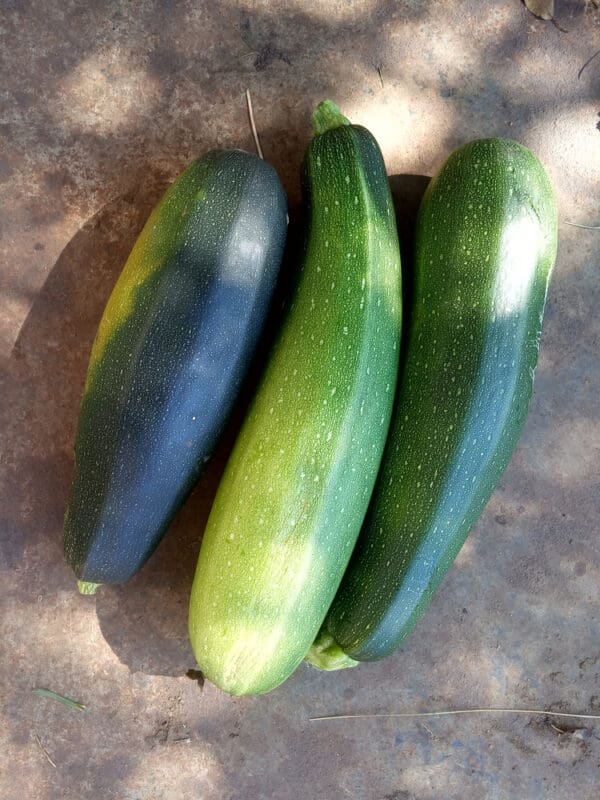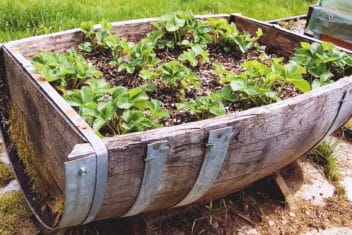I will be honest – this year was not my year when it came to growing zucchini.
That’s something that is hugely frustrating to me, too, since I’ve always found zucchini to be one of the easiest vegetables to grow. However, being heavily pregnant throughout much of the summer, I found that weeding the garden was a chore I struggled with a lot more than usual. After August hit, in fact, I really didn’t weed much at all.
As a result, my zucchini plants grew into dense mats surrounded by weeds. It was hard to see the fruits and even harder to prevent the weeds from overcoming those dense mats. I think the zucchini still grew fine, but it was so difficult to harvest that I often left it there on the vine until it was squishy and unusable. Hey, I’m not saying I’m proud!
However, this frustration with growing squash led me to explore alternative solutions for next year. One that I found (and am absolutely obsessed with!) is the idea of growing zucchini vertically. There are plenty of benefits to doing so, but one of the biggest is that it makes it much easier to weed your plants.
It can also save a lot of space. If you’re trying to grow in an urban garden or simply don’t have a lot of space to commit to growing zucchini, that’s an essential feature to consider. You’ll find that it’s much easier for you to find the fruits as they appear, too. No more zucchini jungle, as my husband likes to affectionately call that section of the garden.
If you’re interested in learning how to grow zucchini vertically, consider following these helpful and practical tips.
What to Use as a Trellis
There are several options when it comes to potential trellises for your zucchini plants.
One option is to use rigid fencing, such as a cattle panel fence rolled into a cage or even a repurposed tomato cage. If you decide to use a tomato cage, just make sure it’s a hefty one. There’s a good chance that your zucchini plants, when loaded with developing fruits, will weigh even more than your heaviest tomatoes.
You can also make more of a flat-angled trellis that’s supported by T-posts or strong stakes. These are usually made out of wood. An A-frame trellis is another option and a good one for gardeners who are concerned about the heavy weight of the zucchini plants toppling the trellis. As long as you drive stakes deeply into the ground, this kind of system should support your plants just fine.
Another benefit of using an A-frame trellis is that you can plant on either side of the “A” and even grow a few shade-loving crops underneath. You’ll be able to really maximize your space.
You can even grow zucchini vertically in things like pallets and planting pouches. These systems are ideal for gardeners in urban environments who would like to grow zucchini on a balcony or patio, perhaps propped up against a wall.
How to Grow Zucchini Vertically

1. Start from Seed
When growing zucchini plants, it’s important that you always start from seed. Zucchini, like most other plants in the squash family, has extremely delicate roots. If you try to get a jumpstart on the season by starting your seeds indoors, you will likely find that the zucchini does not transplant well.
It matures quickly, so there’s no reason to try to get ahead. Simply start your seeds as you normally would after the danger of frost has passed. Choose seeds from verified growers and make sure you have stored them in a cool, dry location so that they don’t become damaged before you plant.
2. Select a Compact Bush Variety
If you plan on growing zucchini vertically, you will have to go with a compact bush variety. Of course, you want to select a variety that you actually enjoy eating. However, selecting one that’s designed to grow in a more contained form is also ideal.
Some of the smallest varieties of zucchini plants (and those that are good for vertical growing) include ‘Spacemiser,’ ‘Gold Rush,’ ‘Sungreen,’ ‘Raven,’ ‘Black Beauty,’ ‘Bush Baby,’ and ‘Eight Ball.’ A lot of today’s hybrid zucchini varieties have been selected specifically for their bushier habits.
3. Grow in Full Sun
Although you may be able to get by when growing your zucchini in the shade, it’s best to grow summer squash in full sun. These plants like a lot of heat! Give your plants as much sunlight as you can in the garden or on your patio, and your work will be much easier.
4. Pick the Right Container and Seed Starting Mix

The main difference between growing zucchini vertically and growing it horizontally is that depending on the system you use to support your zucchini plants, you may need to plant it in a seed starting mix and a container instead of directly in the ground.
For example, if you are planting into a pallet or in pouches (something storebought or homemade pouches like this) you will be planting directly into those vessels and not the ground. Therefore, you’ll have to start with high-quality soil. Do not use topsoil or garden soil in these areas, as it can transmit diseases and pests.
Feel free to apply compost to these spots, though, to add a dose of nutrients both before and after planting.
If you decide to use an A-frame trellis or a more traditional trellis system like a tomato cage, you can plant your seeds directly into the ground and then just train them up the trellis as they grow. It’s still a good idea to add some compost when you plant.
5. Plant One Seed Per Slot
Again, if you are planting in the ground and just plan to use the trellis as a support for your growing zucchini vines, you will plant in the traditional sense – by sowing a few seeds directly into the ground.
However, if you plan to grow directly in a vertical planter (pouches) or in a pallet, you will limit yourself to just one seed per slot. It will be much harder for you to thin these plants out as they grow since the roots will be more shallowly rooted.
Some gardeners recommend planting one seed in every other pouch if you are planting in pockets. This will give your plants plenty of room to sprawl and can also prevent problems with inadequate airflow.
6. Keep the Soil Moist
As your plants develop, be sure to keep the soil adequately moist. Avoid oversaturating the soil. Water the roots rather than the leaves. This will help you prevent problems with disease, like powdery mildew.
Try to water first thing in the morning so that the plants have time to dry out before nightfall. If watering constantly is something you struggle with, there are companies that sell special self-watering planters that come with water reservoirs. Usually located at the top of the planter, these reservoirs are meant to be filled as soon as the soil dries out.
The planter will distribute moisture directly to the roots, just like a drip line.
7. Pay Attention for Pollination
Remember that all kinds of squash plants require pollination, with plants producing both female and male blossoms. Male flowers do not produce fruit yet appear first, so be patient if you don’t see fruit after the plant’s first blossoming.
However, if the female flowers fail to produce fruit, you will need to pollinate them by hand.
In the future, you can prevent issues with pollination by attracting beneficial pollinators to the garden. Consider growing a few pollinator-friendly plants, like bee balm and cosmos, to draw them in.
8. Harvest Frequently

Squash plants are notorious for getting out of hand in a hurry – so try to get in the habit of checking your plants every day to see if the fruits are ready to be harvested. You’d be surprised at how quickly a zucchini can grow when left unattended!
Plus, the more often you harvest your plants, the more fruit they will produce. Leave the fruits on the vine, and it will signal to the plant that it’s time to shut down production.
9. Avoid Powdery Mildew
Powdery mildew is one of the most common nemeses of the backyard gardener. Although it doesn’t immediately kill plants or affect your harvests, it can over time. The best way to avoid it is to make sure your plants are getting adequate ventilation.
One of the biggest benefits of growing vertically is that ventilation is automatically improved. However, you can also reduce the likelihood of powdery mildew by following good watering habits (as mentioned above). You can also use home remedies, like baking soda, to slow the spread of this fungal disease.
Can You Grow Other Vegetables Vertically?

Gone are the days of having to grow in horizontal plots along the ground. Gardening is much more exciting than that! The new trend of vertical gardening has a lot of people (myself included) rethinking how to make the most of their garden space.
You don’t have to limit yourself to just zucchini, either. All kinds of plants can be grown vertically, including other summer squashes, cucumbers, beans, and much, much more.
Be creative. Give it a try with a few of your favorite plants the next growing season you have the chance!












